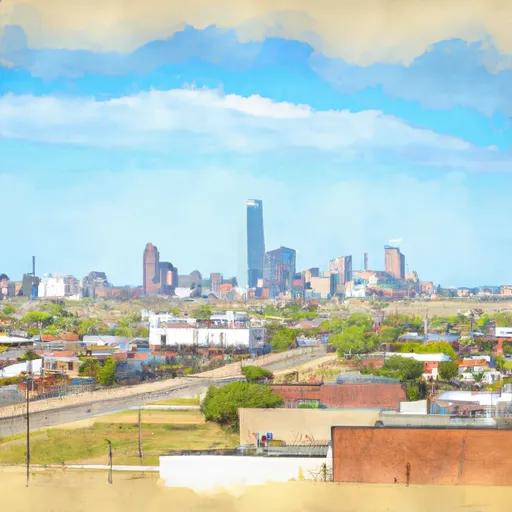-
 Snoflo Premium
Snoflo Premium
Get unlimited access to all our content
With no Ad interruptions! - Start Your Free Trial Login with existing account
Strong-City
Eden Index
Climate
9.8
•
Recreation
1.8
•
Community
1.6
•
Safeguard
4.9/10

Strong City is a small town located in Roger Mills County, Oklahoma. The climate in Strong City is categorized as a humid subtropical climate, with hot summers and mild winters. Summers are typically hot and humid, with temperatures often reaching the high 90s Fahrenheit. Winters are generally mild, with temperatures in the mid-50s. The area receives an average annual precipitation of around 25 inches, with rainfall more evenly distributed throughout the year.
Hydrologically, Strong City is situated near the headwaters of the Washita River, which provides a vital water source for the town and surrounding areas. The river also offers opportunities for fishing and boating, attracting outdoor enthusiasts.
In terms of outdoor recreation, Strong City is surrounded by beautiful natural landscapes, including the Black Kettle National Grassland and the Black Kettle and McClellan Creek National Grasslands. These areas provide opportunities for hiking, camping, bird-watching, and wildlife viewing. Additionally, the nearby Packsaddle Wildlife Management Area offers hunting and fishing opportunities for outdoor enthusiasts.
What is the Eden Index?
The Snoflo Eden Index serves as a comprehensive rating system for regions, evaluating their desirability through a holistic assessment of climate health, outdoor recreation opportunities, and natural disaster risk, acknowledging the profound impact of these factors on livability and well-being.
Climate Health Indicator (CHI): 9.8
Strong-City receives approximately
622mm of rain per year,
with humidity levels near 61%
and air temperatures averaging around
15°C.
Strong-City has a plant hardyness factor of
7, meaning
plants and agriculture in this region tend to thrive during the non-winter months.
By considering the ideal temperature range, reliable water supplies, clean air, and stable seasonal rain or snowpacks, the Climate Health Indicator (CHI) underscores the significance of a healthy climate as the foundation for quality living.
A healthy climate is paramount for ensuring a high quality of life and livability in a region, fostering both physical well-being and environmental harmony. This can be characterized by ideal temperatures, reliable access to water supplies, clean air, and consistent seasonal rain or snowpacks.
Weather Forecast
Streamflow Conditions
Washita
Area Rivers
Washita
Snowpack Depths
Washita
Reservoir Storage Capacity
Washita
Groundwater Levels
Recreational Opportunity Index (ROI): 1.8
The Recreational Opportunity Index (ROI) recognizes the value of outdoor recreational options, such as parks, hiking trails, camping sites, and fishing spots, while acknowledging that climate plays a pivotal role in ensuring the comfort and consistency of these experiences.
Access to outdoor recreational opportunities, encompassing activities such as parks, hiking, camping, and fishing, is crucial for overall well-being, and the climate plays a pivotal role in enabling and enhancing these experiences, ensuring that individuals can engage in nature-based activities comfortably and consistently.
Camping Areas
| Campground | Campsites | Reservations | Toilets | Showers | Elevation |
|---|---|---|---|---|---|
| Supply Park - Fort Supply Lake | None | 1,991 ft | |||
| Beaver Point - Fort Supply Lake | None | 2,015 ft | |||
| Sayre City Park | 80 | 1,799 ft | |||
| Doby Springs Park | 18 | 1,975 ft | |||
| Skipout | 12 | 2,285 ft |
Nearby Ski Areas
Catastrophe Safeguard Index (CSI):
The Catastrophe Safeguard Index (CSI) recognizes that natural disaster risk, encompassing floods, fires, hurricanes, and tornadoes, can drastically affect safety and the overall appeal of an area.
The level of natural disaster risk in a region significantly affects safety and the overall livability, with climate change amplifying these risks by potentially increasing the frequency and intensity of events like floods, fires, hurricanes, and tornadoes, thereby posing substantial challenges to community resilience and well-being.
Community Resilience Indicator (CRI): 1.6
The Community Resilience Indicator (CRI) recognizes that education, healthcare, and socioeconomics are crucial to the well-being of a region. The CRI acknowledges the profound impact of these elements on residents' overall quality of life. By evaluating educational resources, healthcare accessibility, and economic inclusivity, the index captures the essential aspects that contribute to a thriving community, fostering resident satisfaction, equity, and social cohesion.

